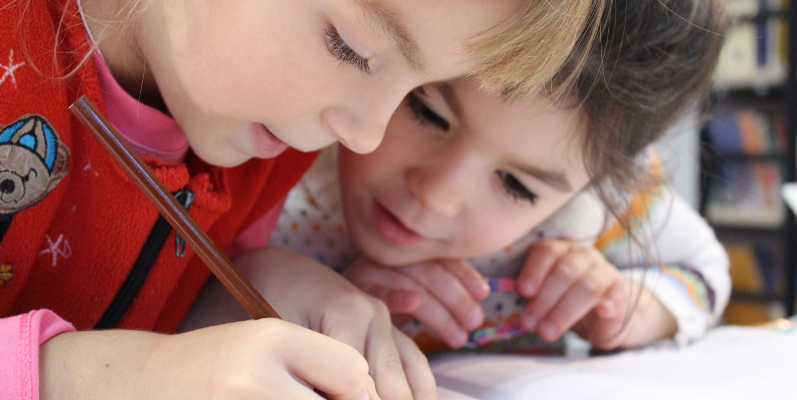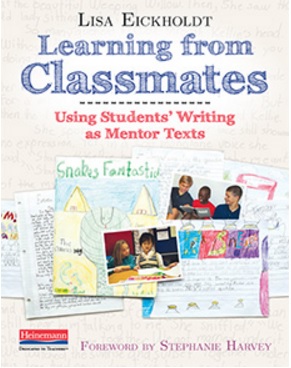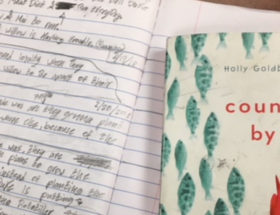This is a repost of a piece that Lisa Eickholdt wrote for That Thing You Do! Using student writing as mentor texts for our kids is powerful practice and the best way to honor their work. Thanks again to @LisaEickholdt!
Lisa Eickholdt is guest blogging for today’s That Thing You Do! segment. She has spent over twenty years in education teaching students and supporting teachers. Lisa is currently Assistant Professor of Literacy Education at Georgia Gwinnett College. She also works as a literacy consultant in classrooms across the U.S. Lisa is the author of Learning From Classmates; Using Students’ Writing as Mentor Texts. You can follow Lisa on Twitter @LisaEickholdt
One key to effective instruction is to provide students with a clear model. This is true in all subject areas, but especially writing. In writing, one powerful way to model is to use a beautiful piece of children’s literature as a mentor text. Children’s literature is so powerful it has become the primary source we turn to when teaching students a new writing technique or strategy. As powerful and important as children’s literature is to the teaching of writing, I believe there is another type of mentor text that we should consider using, writing that I call student mentor text. Student mentor text is beautiful writing by the underused experts in our classrooms: our students.
Why Use Student Mentor Text
I have found student mentor text to be an invaluable resource. When I teach with student pieces, I notice the engagement in the classroom skyrockets or as Carl Anderson observed, “…the engagement level in the classroom rose exponentially”. Using students writing as mentor text is also a great way to increase children’s self-confidence. As an interventionist, I work with striving writers. These writers lack confidence in their writing abilities. Sharing their writing in the minilesson and making a fuss over some clever technique they implemented, is the surest way I have found to boost a child’s self-esteem. The other big advantage student mentor text offers is that it’s developmentally appropriate. No one, certainly not me, would argue against teaching with children’s literature. We owe it to our children to expose them to the most beautiful writing we can find because one thing is certain: what we read, shows up in what we write. But children’s literature is a written by an accomplished adult author. In addition to these polished, published pieces, I believe it’s important to expose children to great writing by their peers. This writing is more developmentally appropriate and therefore, more attainable for most students. Teaching with student mentor text is one of those things I do. In the rest of this post, I hope to convince you to add student writing to your mentor text mix.
Finding and Teaching with Student Mentor Text
The first step to finding student mentor text is to start with the positive. So many times we pull up next to our students to confer (conferring is one of the best times to find mentor text), and instead of noticing the good in their writing, we are blinded by surface feature errors. We get hung up on things like misspelled words, missing punctuation and sloppy handwriting. There is merit in every child’s writing even the most striving writer, but we will miss it if we don’t shift our focus away from conventions and instead focus on content and craft. If this is shift is hard for you, I’d suggest taking a one-month hiatus from conferring on conventions. Most teachers who take this challenge, are amazed: suddenly their kids’ work seems remarkable. I know that remarkable writing has always been there, and now that the teacher’s focus has changed, she is finally able to discover it.
Recognizing the good in our students’ writing is a great first step, but teaching with mentor text requires that we understand what makes the writing good so that we can articulate this to students in our minlessons. Katie Wood Ray suggests that when we read a piece we are contemplating using as mentor text, we first consider what we notice, or what strikes us about it. Once we determine what we like, we need to name this quality. Naming is critical to teaching: when we name something, we make it repeatable. In addition to noticing and naming the beautiful qualities in a piece of writing (Bomer; Ray), I believe we also need to consider how a particular writing technique helps a piece. We will want to explain to students why they might want to use a particular craft move and make a note of why it works. I call this three step process: Notice, Name, and Note (Eickholdt, 2015). Let’s practice using the Notice, Name, and Note protocol to find some possible teaching points in a few pieces of student writing.
Treasure in the Garden, Hadley, 4th grade
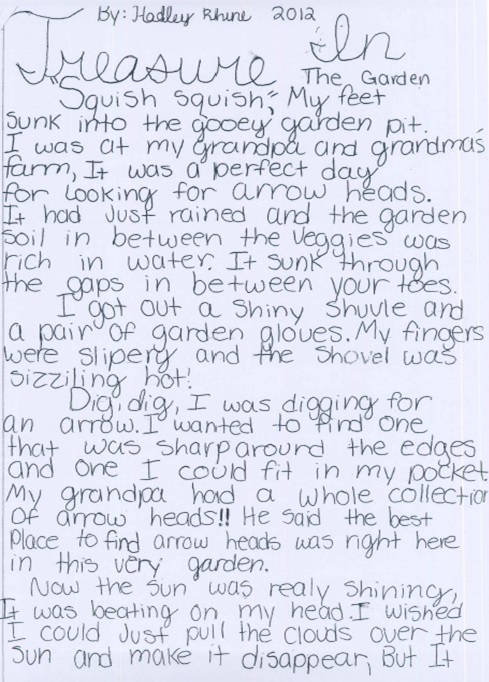
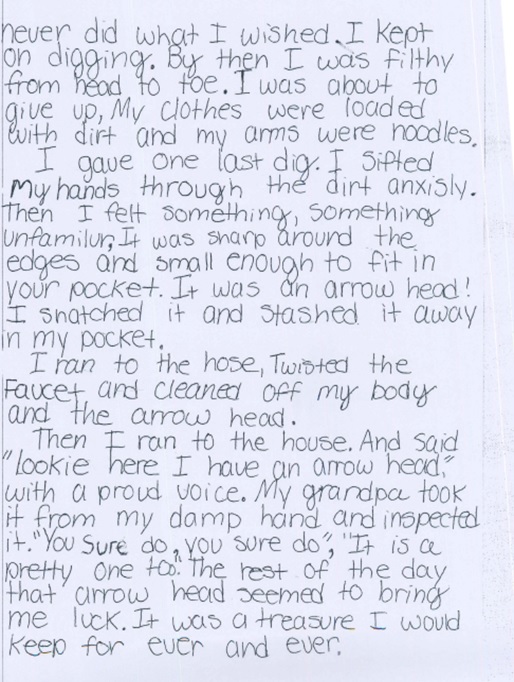
As I read Hadley’s story, the first thing that strikes me is what she didn’t do: Hadley didn’t write what Carl Anderson calls a “bed-to-bed” story. A bed-to-bed story is a story where the writer lists virtually every single thing they did beginning with getting out of bed in the morning and ending with going back to bed that night. When writers don’t write bed-to-bed stories, we say they are writing with focus. Of all the qualities of good writing, focus is one of the most important. Writers must narrow their topic down to a central idea or storyline and stick closely to it. In this piece, Hadley does this beautifully. The central idea of her piece is that she is anxious to find an arrowhead at her grandparent’s house. This idea carries the reader through the whole piece from beginning to end. To keep writing focused, a writer must also avoid including any extraneous details. Again, Hadley does this brilliantly. She doesn’t include details like going on a picnic lunch in the middle of her story because that doesn’t go with her meaning. Focus is a quality that is critical to good writing because a focused piece is much more interesting to read than a “list” story. Focus is one of the qualities that immediately stood out for me in this piece of student writing. As you read through it, I’m certain other things struck you. What did you notice? What is it called? How does it make the writing better? If you found this piece in your classroom, how might you use it?
Hug Me, Daddy, Ashlyn, 3rd grade
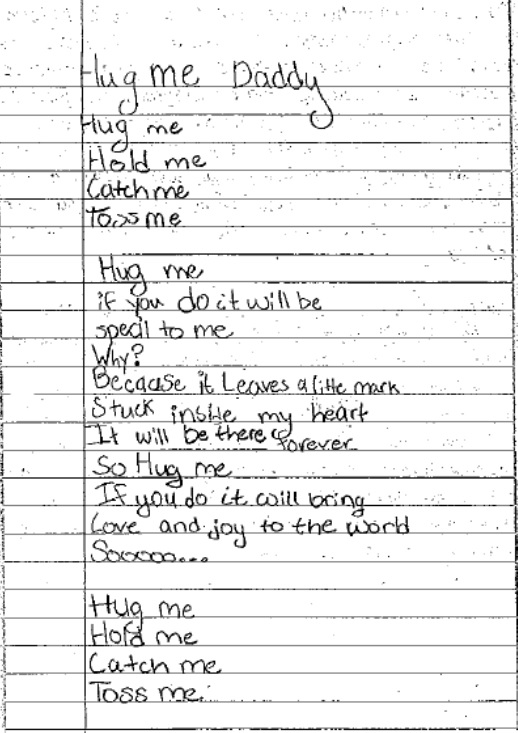
According to Portalupi & Fletcher, poetry is built around three “pillars”: imagery, emotion, and rhythm (music). One of the things I notice about Ashlyn’s poem is her use of repetition. Ashlyn cleverly repeats the first stanza (Hug me, Hold me, Catch me, Toss me) again at the end. Beginning and ending with the same lines is sometimes called bookending. These bookends add rhythm to this piece. What did you notice? What is it called? How does it make the writing better? If you found this poem in your classroom, how might you use it?
Snakes Fantastic!, Ashley, 2nd grade
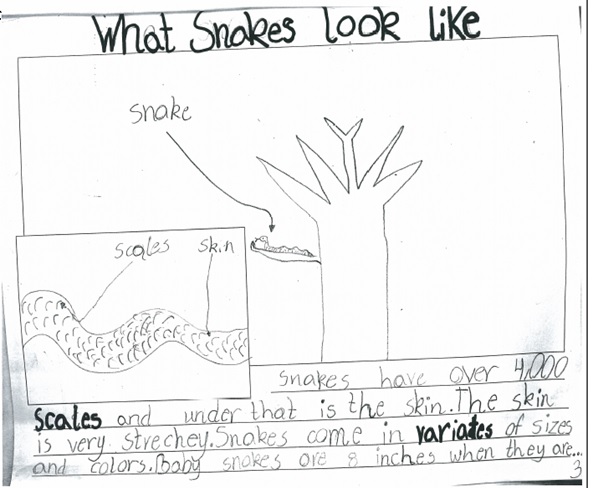
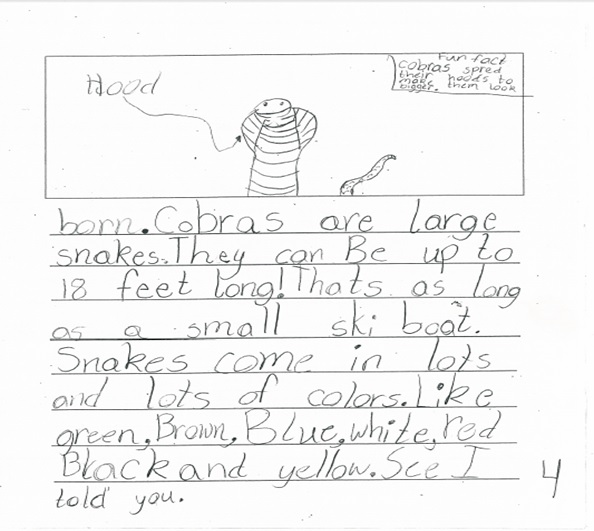
The two pages above are part of a 12-page informational book on snakes. One thing I notice is how Ashley used a variety of nonfiction text features such as headings, bold print (the bolded words appear later in her glossary), labels, a close-up, captions, and a fun fact box. Nonfiction text features are important because they help support the reader as they navigate through the information in a nonfiction text. What did you notice? What is it called? How does it make the writing better? If you found this piece in your classroom, how might you use it?
That Thing We All Do!
I hope after seeing the teaching possibilities in a few pieces of student writing, I have convinced you to try teaching with student mentor text. Once you begin searching for all of the great qualities in your kids’ writing, you will be amazed at how often you can use their work as a model (I teach with my kids’ writing almost every day). I also know that if you add student mentor text to your mentor text mix, you will be rewarded with increased student engagement and enhanced self-esteem. Let’s make teaching with student mentor text one of those things we ALL do. Our kids deserve it!
–Lisa Eickholdt

